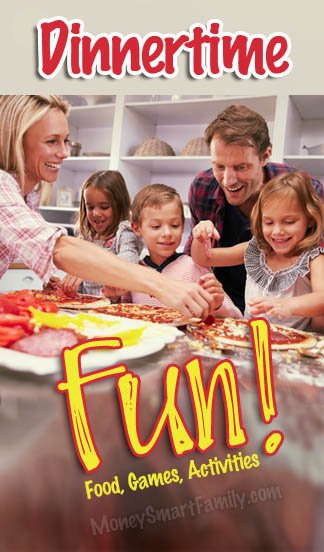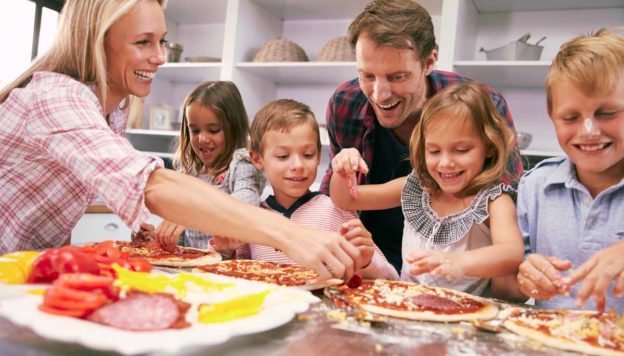If you want to make eating together as a family fun, you’ll love some of the things we do around the dinner table.
The family dinner hour is going the way of the dinosaur and black & white movies. But is the desire to eat meals together an old-fashioned, outdated notion? And with today’s faster-paced, non-relational lifestyle is it even possible?
Eating meals together is a mainstay of a cohesive family unit. Without this time of connection, you could end up with a group of disconnected people just living under the same roof.
Many families aren’t able to do a sit-down family dinner on a daily basis. But if you can pull this off several times each week, your family will be much richer relationally.
Eating together won’t just happen by itself. You may have to work hard, but once it’s established, you’ll never regret having meals together.
TABLE OF CONTENTS
- 1 11 ways we make dinnertime a fun event
- 2 1. Fun Games For The Dinner Table
- 3 2. Get Your Family Involved in Dinner Prep
- 4 3. Encouraging Picky Eaters to Be Daring
- 5 4. Slowing Down Busy Families
- 6 5. Teen’s Work Schedule
- 7 6. Spouse’s Work Schedule
- 8 7. Prepare Dinners on the Weekend
- 9 8. How SAHMs with Preschoolers Can Do Dinner
- 10 9. Simple Cooking Ideas
- 11 10.Getting Support From Your Family
- 12 11. Alternatives to Traditional Dinnertime
- 13 Wrap Up for Around the Dinner Table. Looking Back!
11 ways we make dinnertime a fun event
First, we’ll give you a list of games, activities, and books that we’ve brought to the dinner table to make our mealtime more fun.
Afterward, we’ll share ways that we involved the entire family with dinner time. We did this to make it easier for parents and enjoyable for everyone.
1. Fun Games For The Dinner Table
We are a game-playing, loud laughing family. As a result, we brought those components to dinnertime. Don’t worry, we do teach our kids table manners. And “No” we don’t allow food fights! Although, there were times when we saw a baked potato tossed in response to “pass a potato please.” Give some of these Game ideas a try.
Geography:
We played a simple little game called Geography from Educational Insights. The cards gave us clues and random facts to help us guess which states the clues were describing. We kept score and learned about U.S. geography. The kids especially love playing it when guests come over for dinner.
Mad Libs:
We also love playing
Mad Libs, a fill-in-the-blank story game. This is a way to learn different parts of speech and have fun at the same time. They have created stories based on historical figures or sports or TV shows.
Guests are asked to give nouns, verbs, pronouns, adverbs, and other parts of speech to fill in the blanks of a story. The hilarious part is that they have no clue what the subject of the story is. As a result, we usually end up laughing so hard we have tears in our eyes.
If we have dinner guests, they are invited to participate. It may take a little coaxing, but soon they are participating like pros.
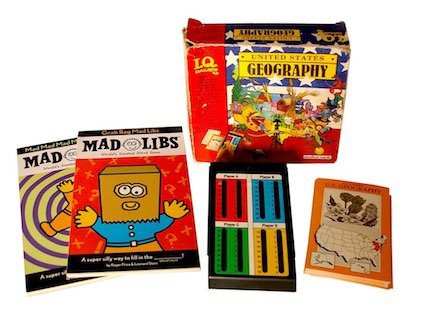
The Famous Person Game:
Write the name of a famous person or extended family member on several name tags or stickers. Give one sticker to each family member to stick to their foreheads. One by one each person asks the group a Yes or No question about the person’s name on their own forehead. Guess the correct name on your forehead and you win. You play until everyone guesses the name on his or her own sticker. Of course, you can give aid to younger children.
Guess Who:
Hand each person at the table a small piece of paper or a 3×5 card. Ask them to describe themselves in only 3 words.
It can be a phrase like “Loves to laugh,” “I hate beets” or, “I love school.” Or it could just be a list of 3 words like “happy, sunshine, sandbox;” or ” toast, eggs, spinach;” or “school, scouts, singing.”
All of the sheets are turned into mom or dad and then read one by one. Everyone guesses and usually laughs too.
Other fun games include Green Glass Doors and I’m Going Camping, but these are only fun when you have a guest at the table.
More Family Table Activities
Gratitude from A to Z: Gratitude is a powerful tonic that can turn a bad day into a great day. Go around the table and let each person share 3 things they’re thankful for. Even the youngest children can participate.
You could also create a thankful book, where you record what each family member is thankful for. We did this using a spiral notebook that we kept in the china hutch by our dining room table. This is a good thing to do twice each month.
Read a Book Out Loud: Whether you have kids or not, reading aloud is always a good thing. We’ve read various books including:
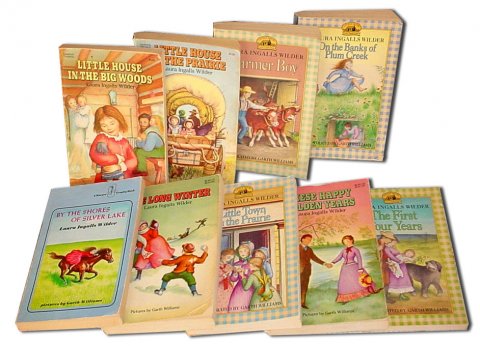
- Little House on the Prairie series by Laura Ingalls Wilder
- Little Britches series by Ralph Moody
- American Girl books
- Christmas in My Heart series by Joe L. Wheeler
- Jim Kjelgaard’s animal stories
- White Fang and Call of the Wild by Jack London
- Where the Red Fern Grows by Wilson Rawls
- Riverboat Adventures by Lois Walfrid Johnson.
- Another great book with short selections is The Rest of the Story by Paul Harvey.
Related Resource: Our list of family favorite chapter books
If you need more ideas, we have lots of our favorite family books listed here.
Read a Letter
We love reading Christmas letters from friends and family. It’s a great way to remember them and discuss what they are doing. It also helps our kids to connect more quickly with our extended family when we get together with them.
We keep in touch with a number of friends who serve as missionaries in foreign countries. It’s fun for all of us to read their letters aloud. We learn so much about the work they do and the uniqueness of the culture where they live.
2. Get Your Family Involved in Dinner Prep

If your kids are less than enthusiastic about what you’re making for dinner get them involved.
Letting kids help with meal planning, setting the table, and cooking the meal engages them with the food you are preparing. Because they’re involved, they’ll be less likely to object.
Centerpieces
Allow one of your kids to decorate the table with a centerpiece of their creation. It can be with toys, cuttings from the yard, stuffed animals, paper cutouts, rocks – let their creativity reign. We would leave the centerpieces up for a week.
Having a rotation of meals is helpful.
This way if tonight’s menu is not enticing to your son or daughter, you can point out that tomorrow you’re serving one of their favorites, and that should help calm their objections.
Just knowing in advance what is going to be served, will give your kids time to be prepared.
We utilized the 3-Bite rule at our house. No matter what was served, you had to try at least 3 bites of everything. If you didn’t finish your meal, you “obviously” weren’t very hungry and didn’t need dessert.
It is really helpful to teach our kids to try and enjoy many different foods. It’s much better for their health and their future.
When our kids have been invited to other homes for a meal, the hostess has been amazed that they were willing to try everything that was served.
Great Recipes for Family Dinners
If you need some inexpensive, family-friendly recipes, check out these pages
- Beef Main Dish Recipes
- Pork Main Dish Recipes
- Chicken Main Dish Recipes
- Vegetarian Main Dish Recipes
3. Encouraging Picky Eaters to Be Daring
According to Parents Magazine and Dr. Keith E. Williams, Ph.D., the director of the feeding program at Penn State Hershey Medical Center, in Pennsylvania, it takes anywhere from 10 to 15 exposures to a new food before it is readily accepted. And once you get the ball rolling with trying new foods, the number of exposures drops to around 6.
So keep bringing out the Brussels sprouts or beets and try different seasonings or dressings. Eventually, your kids will enjoy them.
Research from the National Center for Biotechnology Information NCBI discovered that breast milk changes in flavor slightly. It was determined that what the mother ate four to six hours previously made a difference.
As a result, breastfed babies become accustomed to a variety of flavors. Whereas formula-fed infants get the same flavor at every feeding.
Could this be the reason that breastfed babies tend to be less picky and more willing to try new foods?
4. Slowing Down Busy Families
If you’re convinced that eating dinner together should be a priority, then you may need to minimize some extracurricular activities. Nighttime church activities, sports teams, dance clubs, and education-related activities that occur during dinner often create dinner time disruptions.
When Steve coached sports teams we intentionally scheduled practice times before or after dinner. And if we weren’t in charge of the schedule, we advocated for changes if possible.
Other options would be to eat an earlier or later dinner or to find a different activity or different teams for your kids to be involved in. We tried to select activities for most of our kids that met once each week. These were the easiest to coordinate with our schedule and family time.
If you only have one child, this may not be that big of an issue, but for us, with 5 kids, if we weren’t vigilant, we could have been out at dinner time almost every night of the week.
5. Teen’s Work Schedule
If you’re having trouble getting the family together because your teens have part-time jobs, you may have to really get creative.
We’ve dealt with this issue also. If your teens absolutely have to work a shift that overlaps the dinner hour, encourage your teen to talk to his or her manager about doing it less frequently. Willing managers can create schedules so your teen can possibly be missing dinner once each week, even in the summer.
It might be helpful to find a job where your teen can work afternoon shifts or an evening shift after an early dinner.
A Solution to Shift Dinner Time Conflicts
We’ve helped two of our kids negotiate this issue and both times they have received the schedules they wanted.
One employer actually changed a scheduled shift time permanently. We believe all teens should work, but limiting it to two or three shifts per week during the school year should allow them to earn enough money for their needs.
6. Spouse’s Work Schedule
How can you encourage your spouse to be home for dinner? A long time ago, we went round and round over this issue. Steve was raised in a family where eating together was not a priority. Consequently, it wasn’t important to him.
On the other hand, Annette’s family ate dinner together every night.
After much discussion, Steve finally saw the light because Annette very craftily got the kids to “convince” him. She started reading chapter books at the dinner table. Steve loves to listen to audiobooks and also loves to read out loud in character voices.
Annette made a rule that we would only continue the story when everyone was at the table. She didn’t want anyone to miss the story. Of course, the kids “encouraged” dad to get home on time.
Now dinnertime is one of our favorite daily happenings. Perhaps you can convince your hardworking spouse to limit late nights to only one or two each week.
If he or she absolutely must work later, then have your spouse consider bringing work home to do after the kids are in bed.
No job is worth the sacrifice of time with your family. Exceptions to this might be a doctor in residency or a CPA during tax season. Hopefully, all exceptions will be for a limited, well-defined time.
7. Prepare Dinners on the Weekend
If you and your spouse work outside the home and getting dinner thrown together is difficult, try some of these options.
- Prepare in Advance: Meals can be planned for and prepared the night before or the weekend before.
- Alternate Cooking: You and your spouse could take turns cooking and cleaning up.
- Kids Help: And you have kids who are old enough, they should be included in food prep, table setting, and cleaning up the meal.
- Prepackaged Meals: While prepackaged meals are not our preference if strapped for time, eat them together as a family. It’s better than running to a fast-food drive-thru.
- Teamwork makes the dream work: With a little teamwork, you can pull off a sit-down dinner and get some “me time” too.
8. How SAHMs with Preschoolers Can Do Dinner
If you’re at home with toddlers, infants or pre-schoolers every day — day-in and day-out it may seem impossible to pull dinner together each night.
By the time our fifth child came along, we were using playpens and baby backpacks to help carve out time for dinner preparation. These two tools were lifesavers.
Special Toys for When You’re Preparing a Meal
We also assigned one or two of the older kids to play with the younger ones. They’d pull out a special box of toys, reserved for use only before dinner each night.
A couple of their favorites were
paint with water coloring booksused inside the house or sidewalk chalk used outside — all of the kids would have a ball.
Another lifesaver is once-a-month cooking (members only archive). Remember, the meals don’t have to be gourmet quality, just balanced nutritionally. But just having them prepared in advance will take a lot of the stress out of your day.
9. Simple Cooking Ideas
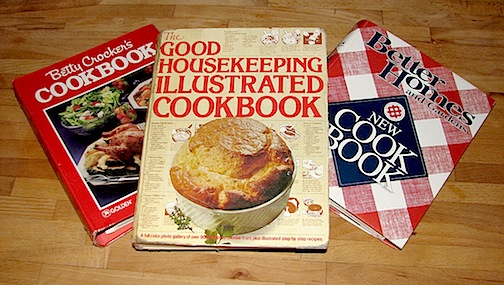
If you didn’t grow up in a family where meals were cooked regularly, you may feel intimidated. There are help and hope. Just start with simple meals, they don’t need to be gourmet.
When we were first married, all that Annette knew how to make in the kitchen was scrambled eggs and boiling water!
She’d call her mom each day, tell her what she wanted to cook and follow mom’s instructions. You could start with a simple seven-day menu until you learn more cooking skills.
Forget those fancy websites that give you a daily menu and shopping list.
Get a basic cookbook and start with simple recipes that don’t overwhelm you.
Check out our favorite cookbooks here.
Come up with a “do-able” menu of 6 or 7 recipes that you can repeat each week. Repeat the cycle several times and slowly add new recipes as you build your repertoire of meals.
Start off with something as simple as the sample dinner menu below.
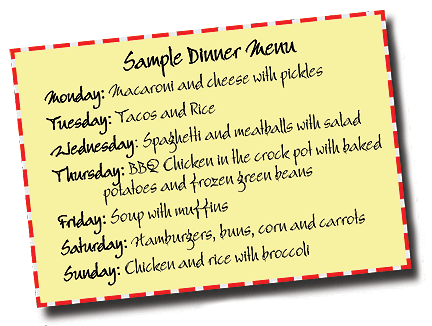
Related Resources:
- Book: Cut Your Grocery Bill in Half (it has a chapter on cooking smarter)
- Audio: Stretching Grocery Dollars
10.Getting Support From Your Family
A few moms have written in saying that they get absolutely no support or gratefulness from their family when it comes to their cooking and dinnertime.
That is so discouraging. We hurt with you, but we don’t believe in quitting.
If eating together as a family is important, keep trying different things. Eventually, you’ll hit on one that works for you and your family.
Annette sees family mealtimes as a cornerstone of a healthy family. No one person in a family should be breaking their backs over anything. Enlist the kids’ help and lavish plenty of praise. Minimize your concern for spotlessness.
Don’t Worry About Messes
Kids will be messy at first, but you are training them in teamwork, not just using them as slave labor. We didn’t stress about spills at the table because we always served water. Clean up was super simple.
Technology Free Time
Turn off the TV, put all technology in a basket and spend time together until the meal is completely prepared and eaten. If they complain, you can tell them that Annette said this was how we do it in our house.

Keeping it a Priority
We have some dear friends who run a large family business. They struggle desperately to get family time with their two teens.
A while back they were over at our house for dinner and Annette was drawn into a debate between the teens and their parents. The parents wanted Sunday to be their family day — no friends, just their family.
The kids thought they’d be considered absolute freaks by their peers and wanted to be able to see their friends on Sunday. Yet Sunday was the only day this family didn’t have to go to the business and work.
Then the kids made a tactical error, they said, “No one does what you’re asking us to do!” Annette smiled and said, “That is exactly what our family does every Sunday AND for dinner every night!” That ended the debate and the teens just sulked away licking their wounds.
Family mealtimes are important and worth fighting for. We laugh and yell and pray and shout at dinner time. Sometimes we even jump for . . . well, we jump to avoid the glass of water spilled by some arm swinging storyteller talking about their day. It’s worth every bit of effort put into it and it’s never boring that’s for sure.
11. Alternatives to Traditional Dinnertime
We know some families where dinner time together just can’t happen. One pastor’s family made a point to have breakfast together every day. That was their time of connection.
Another single mom with teen daughters did “Tea at Ten.” They sat down each evening sipping a warm drink and reviewed the day. What a sweet time of connection.
Wrap Up for Around the Dinner Table. Looking Back!
You may have to work hard to make mealtime happen and to make it fun, but it is so worth the effort.
Now, with our kids grown, it is so heartwarming to see them doing some of the same things we did as a family. AND it’s even more encouraging when they come over for a special dinner celebration and they say, “Let’s do Mad Libs!”
The laughter and unity are so worth the effort.
Here’s a great article about the importance of dinnertime.
Another great resource for you is this Family Dinner website.
